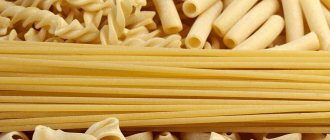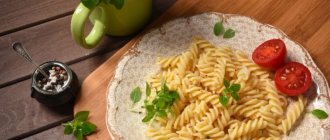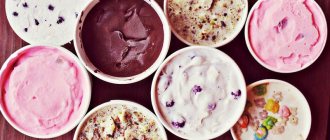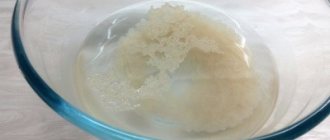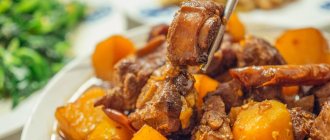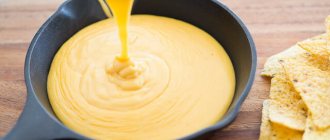Cottage cheese - no one would probably dare to dispute this fact - is a valuable product that has been used by humanity for many millennia. It is known that even in Ancient China, for example, they learned to prepare it (although among monks it was distributed in dry form, like kefir, for the sake of convenience and shelf life). But glazed cheese curds are a relatively new product, emerging only in the middle of the last century, but already loved by both children and adults. Although some nutritionists question its real benefits. In recent years, the production of glazed cheese curds has been developing at a fairly rapid pace (and, as food industry experts say, it will continue to grow). The range of fillings is expanding, new manufacturers and product designs are appearing. What are glazed cheese curds, what is their composition, is there any benefit from eating them regularly? We will try to answer these and other equally interesting questions in our article.
Great multitude
It must be said that glazed cheese curds are a very popular product. Although, for example, similar analogues of these butter-curd sweets are not produced on the European or Asian markets. They can be produced with vanilla, and with chocolate chips, and with various various fillings in the form of jams. There are also premium glazed cheesecakes in Russia, which cost several times more than regular ones. Unlike their counterparts, they are covered not with ordinary glaze (cocoa content - up to 15%), but with real chocolate (75-77%). And inside there are much fewer additives and much more cottage cheese itself. In Russia alone (not to mention other CIS countries), there are about 300 enterprises producing glazed cheese curds. And among the new flavors are salty (unsweetened) types with a reduced calorie content for people on a diet and suffering from diabetes.
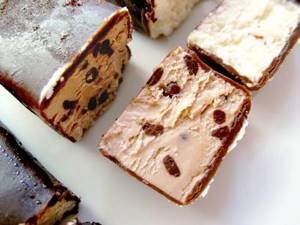
Composition and nutritional value
What does this now classic glazed curd dessert consist of? Traditionally, its recipe includes: cottage cheese, butter, sugar, vanillin. Often inside there is a small dose of some kind of filling in the form of jam from fruits or berries (sometimes just natural fruits or berries that have undergone heat treatment, for example, dried apricots or prunes). As a result, glazed cheese curds are highly nutritious, since they contain both proteins and carbohydrates. The mass of cheese in the usual factory version is 40-50 grams.
Calorie content Cheese. Chemical composition and nutritional value.
Nutritional value and chemical composition of “Cheese”.
The table shows the nutritional content (calories, proteins, fats, carbohydrates, vitamins and minerals) per 100 grams of edible portion.
| Nutrient | Quantity | Norm** | % of the norm in 100 g | % of the norm in 100 kcal | 100% normal |
| Calorie content | 390 kcal | 1684 kcal | 23.2% | 5.9% | 432 g |
| Squirrels | 7.7 g | 76 g | 10.1% | 2.6% | 987 g |
| Fats | 25.8 g | 56 g | 46.1% | 11.8% | 217 g |
| Carbohydrates | 32.1 g | 219 g | 14.7% | 3.8% | 682 g |
| Organic acids | 0.5 g | ~ | |||
| Water | 41 g | 2273 g | 1.8% | 0.5% | 5544 g |
| Ash | 0.9 g | ~ | |||
| Vitamins | |||||
| Vitamin A, RE | 110 mcg | 900 mcg | 12.2% | 3.1% | 818 g |
| Retinol | 0.1 mg | ~ | |||
| beta carotene | 0.06 mg | 5 mg | 1.2% | 0.3% | 8333 g |
| Vitamin B1, thiamine | 0.03 mg | 1.5 mg | 2% | 0.5% | 5000 g |
| Vitamin B2, riboflavin | 0.3 mg | 1.8 mg | 16.7% | 4.3% | 600 g |
| Vitamin B4, choline | 46.7 mg | 500 mg | 9.3% | 2.4% | 1071 g |
| Vitamin B5, pantothenic | 0.28 mg | 5 mg | 5.6% | 1.4% | 1786 |
| Vitamin B6, pyridoxine | 0.11 mg | 2 mg | 5.5% | 1.4% | 1818 |
| Vitamin B9, folates | 35 mcg | 400 mcg | 8.8% | 2.3% | 1143 g |
| Vitamin B12, cobalamin | 1 mcg | 3 mcg | 33.3% | 8.5% | 300 g |
| Vitamin C, ascorbic acid | 0.5 mg | 90 mg | 0.6% | 0.2% | 18000 g |
| Vitamin D, calciferol | 0.138 mcg | 10 mcg | 1.4% | 0.4% | 7246 g |
| Vitamin E, alpha tocopherol, TE | 0.4 mg | 15 mg | 2.7% | 0.7% | 3750 g |
| Vitamin H, biotin | 5.1 mcg | 50 mcg | 10.2% | 2.6% | 980 g |
| Vitamin RR, NE | 2.2 mg | 20 mg | 11% | 2.8% | 909 g |
| Niacin | 0.3 mg | ~ | |||
| Macronutrients | |||||
| Potassium, K | 112 mg | 2500 mg | 4.5% | 1.2% | 2232 g |
| Calcium, Ca | 135 mg | 1000 mg | 13.5% | 3.5% | 741 g |
| Magnesium, Mg | 23 mg | 400 mg | 5.8% | 1.5% | 1739 |
| Sodium, Na | 41 mg | 1300 mg | 3.2% | 0.8% | 3171 g |
| Sera, S | 71 mg | 1000 mg | 7.1% | 1.8% | 1408 g |
| Phosphorus, P | 200 mg | 800 mg | 25% | 6.4% | 400 g |
| Chlorine, Cl | 152 mg | 2300 mg | 6.6% | 1.7% | 1513 g |
| Microelements | |||||
| Aluminium, Al | 50 mcg | ~ | |||
| Iron, Fe | 0.4 mg | 18 mg | 2.2% | 0.6% | 4500 g |
| Yod, I | 9 mcg | 150 mcg | 6% | 1.5% | 1667 g |
| Cobalt, Co | 1 mcg | 10 mcg | 10% | 2.6% | 1000 g |
| Manganese, Mn | 0.008 mg | 2 mg | 0.4% | 0.1% | 25000 g |
| Copper, Cu | 74 mcg | 1000 mcg | 7.4% | 1.9% | 1351 g |
| Molybdenum, Mo | 7.7 mcg | 70 mcg | 11% | 2.8% | 909 g |
| Tin, Sn | 13 mcg | ~ | |||
| Selenium, Se | 30 mcg | 55 mcg | 54.5% | 14% | 183 g |
| Strontium, Sr | 17 mcg | ~ | |||
| Fluorine, F | 32 mcg | 4000 mcg | 0.8% | 0.2% | 12500 g |
| Chromium, Cr | 2 mcg | 50 mcg | 4% | 1% | 2500 g |
| Zinc, Zn | 0.394 mg | 12 mg | 3.3% | 0.8% | 3046 g |
| Digestible carbohydrates | |||||
| Mono- and disaccharides (sugars) | 27.5 g | max 100 g | |||
| Lactose | 1.5 g | ~ | |||
| Sucrose | 26 g | ~ | |||
| Sterols (sterols) | |||||
| Cholesterol | 69 mg | max 300 mg | |||
| Saturated fatty acids | |||||
| Saturated fatty acids | 13.7 g | max 18.7 g | |||
| Monounsaturated fatty acids | 6.75 g | min 16.8 g | 40.2% | 10.3% | |
| Polyunsaturated fatty acids | 1.3 g | from 11.2 to 20.6 g | 11.6% | 3% | |
| Omega-3 fatty acids | 0.19 g | from 0.9 to 3.7 g | 21.1% | 5.4% | |
| Omega-6 fatty acids | 1.13 g | from 4.7 to 16.8 g | 24% | 6.2% |
The energy value of the cheese is 390 kcal.
Primary Source: Created in the application by the user. Read more.
** This table shows the average levels of vitamins and minerals for an adult. If you want to know the norms taking into account your gender, age and other factors, then use the “My Healthy Diet” application.
A little history
There is a version that a similar product was made back in the 19th century (Russia, Altai). But it is traditionally accepted that the birth years of this dessert were still the thirties of the last century. And these products appeared in Soviet stores after the war, in the 50s. Cheeses have become very popular, and their vanilla flavor is very popular with children, as an alternative to rather expensive chocolate and candies. Moreover, for some, the glaze containing cocoa was also an independent delicacy: it was supposed to be bitten off and eaten separately from the general curd mass, which was no longer very interesting to eat afterwards. In the 80s of the last century, for some reason, this product became scarce, and appeared on the shelves only in the 90s. And in 1995, there were already hundreds of producers of this wonderful dessert. By the way, the shelf life of the first cheese curds did not exceed three days, they did not contain preservatives and were packed in non-airtight foil. Then sealed packaging was used, which made it possible to expand the range and increase shelf life (but subsequently substances that preserved the product were also introduced into the composition).
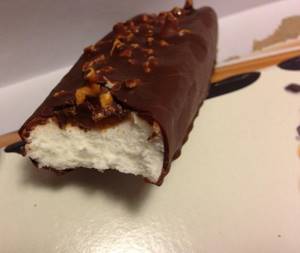
Benefits and possible harm
It must be said that, despite their widespread popularity, some nutritionists and doctors treat these desserts with great suspicion. They start with the fact that glazed cheese, the calorie content of which is simply off the charts, cannot be consumed regularly, especially by those people who watch their figure. Because, according to Russian tradition, cheesecakes alone are not enough. Usually a couple of sandwiches, sweet coffee, something else are added to breakfast - and hello, excess weight! In addition, some unscrupulous manufacturers tend to add low-quality fats to cheese curds, which are then poorly absorbed by the body. In addition, the composition of the modern product is significantly different from the curd cheeses of the 50s. It contains dyes, preservatives, and flavor enhancers, which also does not add any usefulness to it. And also, during a scrupulous study, scientists found cholesterol that is harmful to the body. People suffering from diabetes, vascular and heart diseases are not recommended to consume dessert. And when purchasing cheese curds for future use in the supermarket, you should pay close attention to the expiration dates: they are still not very long.
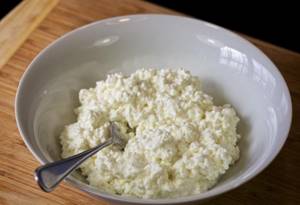
Calorie content of glazed cheese curds
Glazed curd cheese is one of the most favorite sweets of all children. Sometimes adults don’t mind enjoying a sweet treat either. There is a choice for every taste: you can find a delicacy with raisins and dried apricots, vanilla and chocolate, coconut and banana, jam and condensed milk.
Compound
Curd dessert is a tempting treat. Usually, in addition to cottage cheese, the composition of a curd delicacy includes:
The product also includes chocolate glaze.
Often, in the composition indicated on the product packaging, you can find a list of various chemical additives (stabilizers, emulsifiers, sweeteners, flavors). Sometimes manufacturers replace milk fat with palm oil.
Such components are not beneficial to human health, but are widely used in the food industry to increase the shelf life of products, as well as to give them a particularly bright taste.
If you are an ardent opponent of such additives, then you will have to prepare such a delicacy at home yourself, because in almost all industrially produced cheesecakes you will find artificial ingredients.
The main component of the product is cottage cheese. It is rich in a number of vitamins and microelements necessary for the full functioning of the human body.
Cottage cheese contains calcium, phosphorus, potassium, magnesium, as well as vitamins A, E, C and group B. In addition, here you will find a number of essential amino acids (protein components).
These amino acids include lysine, tryptophan, methionine and others.
Calorie content and BZHU
100 grams of product contain on average about 400 kcal. By simple calculations you can determine that for 1 pc. accounts for approximately 160-200 kcal.
The BJU in the product is as follows:
- 7-10 g proteins (proteins);
- 36-48 g carbohydrates;
- 21-24 g fat.
The amount of calories, as well as proteins, fats and carbohydrates in glazed cheese curds can vary significantly. It all depends on what components are added to the product (pieces of fresh or dried fruit, jam, condensed milk, cocoa powder, raisins).
In low-calorie cheese curds, the number of calories can be halved and amount to 200 kcal per 100 grams of product.
Benefits and harms
Like any other product, curd delicacy has a number of properties. Some of them have a positive effect on the human body, others have a negative effect.
Since dessert has a fairly high energy value, it can quickly saturate the body. This property is important for those people who engage in heavy mental or physical work, as well as for those who want to quickly restore lost strength.
In addition, glazed cheese curds are sweet, which means that consumption of the product can help improve mood and increase the level of the happiness hormone. The treat also significantly reduces stress levels and is a means to prevent depression.
Some researchers indicate that moderate consumption of this product stimulates the gastrointestinal tract.
Despite such a variety of positive qualities, curd dessert can also cause harm to the body. Chemical and artificial additives included in the treats have a negative effect on metabolic processes.
You need to read the label carefully to avoid trouble and health problems. People who are prone to allergies or cannot tolerate any components of the product should be especially careful.
Due to the high fat content in the product, curd cheese should not be consumed by people suffering from peptic ulcers and other gastrointestinal diseases.
The glazed treat is not a dietary product, so it should be avoided by those people who dream of losing weight and are actively watching their figure. Systematic consumption of cheese curds in large quantities can lead to extra pounds or even obesity. You can always make the lowest-calorie cheesecakes yourself.
When preparing a healthy treat at home, you will be absolutely sure of the quality of the ingredients added to the dish.
How to cook at home?
To prepare a delicious treat with your own hands you will need:
- 300 g cottage cheese;
- 80 g butter;
- 70 g sugar;
- 150 ml cream;
- 70 g chocolate for glaze.
First you need to mix the cottage cheese and butter, then add sugar to the mixture and mix the ingredients thoroughly until smooth. The next step is the formation of curds. They can be given any shape.
To prepare the glaze, melt the chocolate in a water bath and mix it with cream. Dip the cheesecakes in the glaze and put them in the refrigerator. The product is ready to use when the glaze hardens.
You will learn more about glazed cheese curds in the following video.
Ingredients
To prepare glazed cheese curds at home, you need to take 700 grams of low-fat cottage cheese, 50 grams of cream, 50 grams of cow butter without vegetable additives, half a glass of powdered sugar, a bar of good chocolate (50% cocoa content and higher), vanillin, jam filling or natural fruits. If you cook at home, then use fresh and high-quality ingredients!

Benefits, harms, calorie content of cheese per 100 grams
> Calorie content, benefits, harm of products > Dairy products > Benefits, harm, calorie content of cheese per 100 grams
The calorie content of cheese per 100 grams depends on the type and composition of the product. This note presents the content of calories, proteins, fats, carbohydrates in glazed, curd, and processed cheeses.
Calorie content of Prostokvashino cheese per 100 grams
Calorie content of glazed curd cheese Prostokvashino per 100 grams is 391 kcal. In 100 g of sweets:
- 7.2 g protein;
- 24.7 g fat;
- 35 g carbohydrates.
Read: Calorie content of fish and potato soup
The composition of the product includes cottage cheese, sugar, milk fat substitute, thickener, and confectionery glaze.
Due to their high fat content and calorie content, such curds should be avoided if you are overweight, during a diet, or during exacerbation of liver and gastrointestinal diseases.
Calorie content of Miracle cheese per 100 grams
Calorie content of glazed cheese Miracle per 100 grams is 397 kcal. In a 100-gram serving of this sweet:
- 8.7 g protein;
- 25.6 g fat;
- 33 g carbohydrates.
The cheese contains cottage cheese, butter, thickener, sugar, preservative, stabilizer, cocoa powder, cocoa butter substitute, milk fat substitute, and flavorings.
Calorie content of glazed cheese in 1 piece
The calorie content of 1 glazed cheese curd depends on the type of product. The average weight of one such sweet product is 100 – 115 grams. Thus, in 1 pc. sweets contain approximately 390 - 448 kcal, 8.5 - 9.7 g protein, 25.5 - 29.3 g fat, 33 - 37.9 g carbohydrates.
Calorie content of vanilla cheese per 100 grams
The calorie content of vanilla curd per 100 grams (using the example of Fanny’s products) is 268 kcal. In 100 g of product:
- 10 g protein;
- 20 g fat;
- 12 g carbohydrates.
Read: Calorie content of boiled spaghetti Makfa
It should be noted that the product has a fairly simple and natural composition. The ingredients of the product are fermented milk cheese, butter, sugar, including vanilla.
Calorie content of Alexandrov cheese in milk chocolate per 100 grams
Calorie content of glazed Alexandrov cheese per 100 grams is 419 kcal. In 100 g of sweets:
- 8.46 g protein;
- 28.36 g fat;
- 32.53 g carbohydrates.
The composition of the cheese includes cottage cheese, sugar, milk chocolate, butter, natural vanilla extract.
Calorie content of Rostagroexport cheese per 100 grams
Calorie content of Rostagroexport curd cheese per 100 grams is 350 kcal. In 100 g of treat:
- 10 g protein;
- 19 g fat;
- 34 g carbohydrates.
For the production of cheese curds, sugar, cottage cheese, confectionery glaze, flavoring, and butter are used.
Calorie content of processed cheese Druzhba per 100 grams
Calorie content of Druzhba cheese per 100 grams is 201 kcal. In 100 g of product:
- 10 g protein;
- 13.5 g fat;
- 10 g carbohydrates.
Read: Boiled salmon: calorie content per 100 grams
The composition of the cheese includes cheeses, butter, skimmed milk powder, whey powder, drinking water, cottage cheese, thickener, complex food additive, salt, flavorings, citric acid, and preservatives.
Calorie content of processed cheese Amber per 100 grams
The calorie content of Yantarny cheese per 100 grams is 289 kcal. In 100 g of product:
- 7 g protein;
- 27.3 g fat;
- 4 g carbohydrates.
The composition of processed cheese is represented by fat and low-fat cheeses, butter, coconut oil, skimmed and whole milk powder, drinking water, stabilizer, emulsifier, cottage cheese, and edible vegetable protein.
Calorie content of Svetlogorye cheese per 100 grams
Calorie content of Svetlogorye glazed cheese per 100 grams is 410 kcal. In a 100 gram serving of the product:
- 7.3 g protein;
- 28.2 g fat;
- 31.7 g carbohydrates.
The composition of the cheese includes sugar, cottage cheese, confectionery glaze, food flavoring and butter.
Calorie content of curd cheese with raisins per 100 grams
The calorie content of curd cheese with raisins per 100 grams (using the example of Derevensky Dairy Plant products) is 154 kcal. In a 100-gram serving of sweet product:
- 13.8 g protein;
- 4.3 g fat;
- 15 g carbohydrates.
Read: Water pancakes: calorie content per 100 grams
The composition of the cheese is represented by sugar, cottage cheese, raisins, vanillin.
Calorie content of cheese with condensed milk per 100 grams
The calorie content of cheese with condensed milk per 100 grams (sweet products Korovka from Korenovka are considered) is 364 kcal. In 100 g of sweets:
- 5 g protein;
- 20 g fat;
- 41 g carbohydrates.
For the production of cheese curds, sugar, cottage cheese, chocolate glaze, whole condensed milk with sugar, and butter are used.
The benefits of glazed cheese curds
The beneficial properties of glazed cheese curds include:
- such sweets have a high energy value, therefore they quickly saturate the body with energy during hard physical and mental work;
- the product increases the level of the happiness hormone, ensuring the prevention of depression, apathy, and stress;
- Moderate consumption of such cheeses stimulates the gastrointestinal tract.
Harm of glazed cheese curds
The harmful properties of glazed cheese curds include:
- sweetness is saturated with fast carbohydrates, which are limited during a diet, with excess weight, obesity;
- preservatives and unnatural flavoring additives in cheese curds slow down metabolic processes in the body, causing excess weight gain and swelling (due to these ingredients, fluid may be retained in the body);
Read: Filo dough: calorie content per 100 grams
- due to their high fat content, curd cheeses are contraindicated in cases of exacerbation of cholecystitis, pancreatitis, gastric and intestinal ulcers;
- some people experience intolerance to the components of the product, including manifesting itself in the form of bloating, flatulence, heaviness in the stomach;
- Sweet cheeses should not be given to children under 3 years of age.
By clicking the button, I agree to the newsletter, the processing of personal data and accept the privacy policy.
Recipe
So, let's prepare homemade glazed cheesecakes. The recipe is quite simple to make - even a novice cook can do it.
- Mix the curd mass with pre-softened butter, cream and powdered sugar. The mixture should not turn out too thin and liquid.
- Add vanillin at the tip of a knife. At this stage, you can also add ground nuts and cocoa powder to the “dough” itself.
- We fashion small rectangular cheesecakes from the resulting mass. Add half a spoonful of filling inside, if any. Place the shaped curds in the freezer to harden (but do not freeze completely).
- Now let's prepare the glaze. It will, of course, taste different from store-bought chocolate, since the chocolate we use contains more cocoa beans. Melt the chocolate bar in a water bath. Pour the resulting liquid chocolate over each cheese on all sides and place the product produced in the kitchen on a plate. We put it back in the freezer for a while so that the chocolate turns into a frozen glaze. Each cheese must be kept separately in the container! After some time, remove from the freezer and eat. You can store such delicious and healthy homemade desserts in the refrigerator for several days (maximum three). But, as a rule, cheese curds do not “live up” to this and risk being eaten earlier (especially if there are children or a husband with a sweet tooth in the house).
